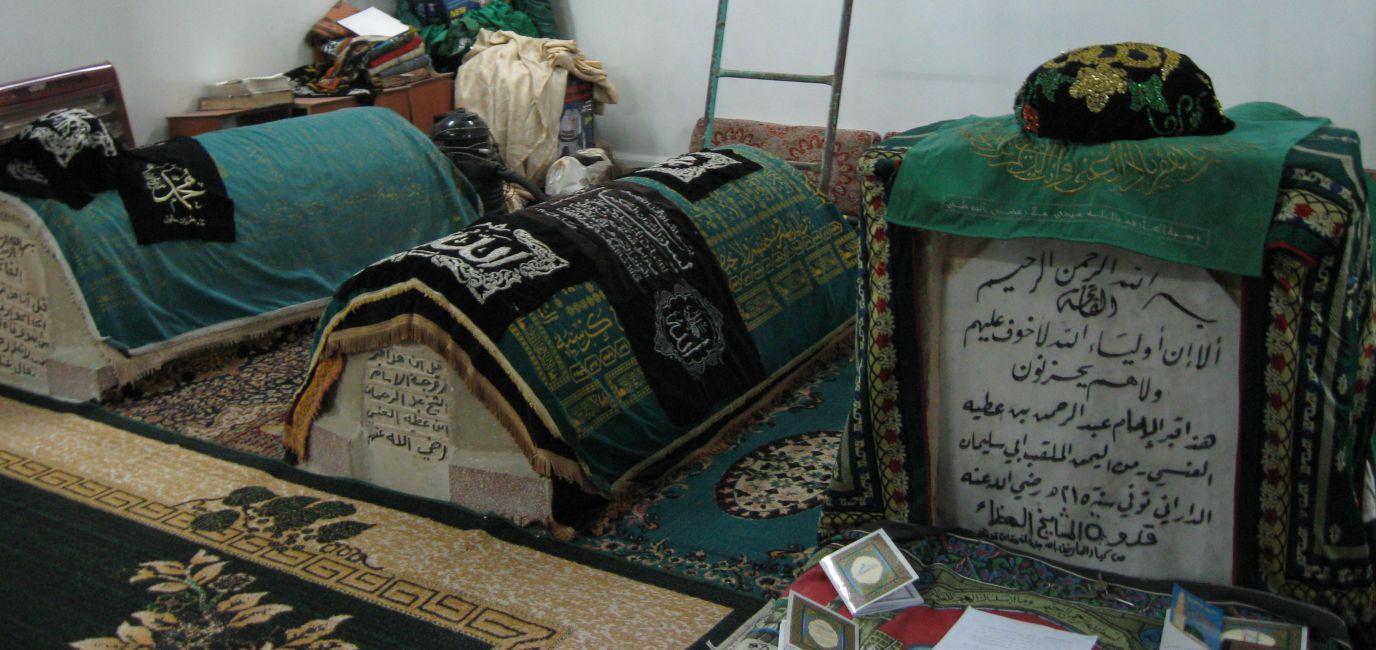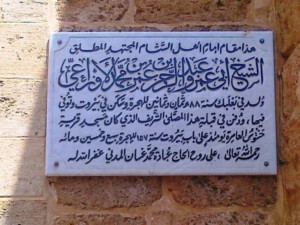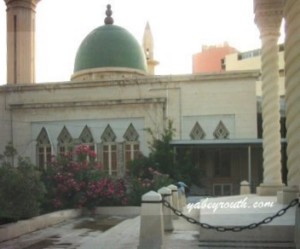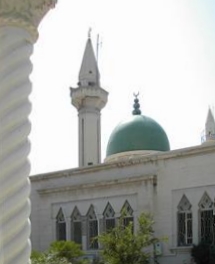153 Search results
Bio: Abu al-Bayan

Abu al-Bayan
أبو البيان نبأ بن محمد بن محفوظ القرشي الدمشقي
d. 551 H. in Damascus
radiya Allah anhu
Nabâ ibn Muhammad ibn Mahfûzh al-Qurashi al-Dimashqi
Scholar of language and fiqh, murshid. He used to study shafi`i fiqh together with Sheikh Rislan in a mosque in the grand suq near Bab Sharqi.
Buried in Bab al-Saghir.
References: Ziarat al-Sham
© Damas Cultural Society 2007 — Latest update:
Original site: damas-original.nur.nu
Bio: Abu al-Ma`ali al-Nisaburi

Abu al-Ma`ali al-Nisaburi
أبو المعالي النيسابوري
d. 578
radiya Allah anhu
أبو المعالي نسعود بن محمد بن مسعود النيسابوري
orator, preacher, shafi`i scholar, lived in damascus, buried in the sufi graveyard
References: [Ziarat al-Sham p.334-5] – Damas Cultural Society © 2007
Bio: Abu Bakr al-`Arudiki

Abu Bakr al-`Arudiki
born 584 – d. .. H. in Damascus
radiya Allah anhu
Of Ahl al-mahabba wa al-tawhid.
Buried at the foot of Qasiun on the western side [Ziarat al-Sham]
Damas Cultural Society © 2007
Bio: Abu Darda

Abu Darda
أبو الدرداء الأنصاري الخزرجي
d. 32 H. (653 CE) in Damascus (sahabi)
radiya Allah anhu
Bio: Abu Dharr al-Ghafari

Abu Dharr al Ghafari
أبو ذر الغفاري
d. 32 H. in Rabdha, near Madina
radiya Allah anhu
Bio: Abu Muslim al-Khawlani

Abu Muslim al-Khawlani
“The inburnable”
d. 62 H. in Daria, Damascus
أبو مسلم الخولاني
radiya Allah anhu
Bio: Abu Nu’aym Al-Asbahani

Abu Nu`aym Al-Asbahani
أبو نعيم الأصبهاني
b. 336 – d. 430
radiya Allah anhu
Bio: Abu Shamah al-Maqdisi

Abu Shamah Shihab al-Din al-Maqdisi
b. 599 – d. 665 in Damascus (1202-1267 CE)
الإمام عبد الرحمان بن إسماعيل بن إبراهيم عثمان المقدسي ثم الدمشقي، المعروف بأبي شامة
radiya Allah anhu
Bio: Abu Sulayman al-Darani

Abu Sulayman al-Darani
أبو سليمان عبد الرحمن بن عطية الداراني
(d. 215 H. in Dara near Damascus)
radiya Allah anhu
﷽
 Biography in Al-Risala al-Qushayriyya – t.b.d.
Biography in Al-Risala al-Qushayriyya – t.b.d. Biografi Abu Sulayman al-Darani ur al-Qusayri’s Risala, övers. Göran Ogén
Biografi Abu Sulayman al-Darani ur al-Qusayri’s Risala, övers. Göran Ogén
Bio in English
عربي
Svenska
 Biografi ur al-Qusayri’s Risala
Biografi ur al-Qusayri’s Risala
Biografi Abu Sulayman al-Darani ur Al-Risala al-Qushayriyya
Övers. Göran Ogén
12. Abū Sulaymān cAbd al-Rahmān bin cAtīya al-Dārānī(1)
1. [Han] kom från Dārān(2), en av byarna kring Damaskus, och dog år 215 (år 830 A.D.). Jag hörde Muhammad al-Husayn säga, att cAbd Allāh bin Muhammad al-Rāzī sagt, att han hört Ishaq bin Ibrāhīm bin Abū Hassān säga, att han hört Ahmad bin Abū ‘l-Hawārī säga, att han hade hört Abū Sulaymān säga ‘Den som gör gott om dagen belönas om natten, och den som gör gott om natten belönas om dagen. Om någon uppriktigt försöker lämna ett begär, så avleder Gud det från hans hjärta. Gud den högste är alltför ädel för att plåga ett hjärta med ett begär, som man vill lämna för Hans skull!’.
2.Enlig samma berättarkedja [isnād] sade han också: »När Denna världen dväljes i ett hjärta förflyttar sig Den kommande världen bort från det.»
3. Jag hörde sufimästaren Abū cAbd al-Rahmān al-Sulamī {Gud förbarme sig över honom!} säga, att han hört al-Husayn bin Yahyā säga, att han hört Djacfar bin Muhammad bin Nusayr säga, att han hört al-Djunayd säga, att Abū Sulaymān ad-Dārānī hade sagt: »Ibland hamnar något folkligt talesätt i mitt hjärta [och ligger där] några dagar, men [sen] tar jag det till mig endast utifrån två välgrundade vittnen: Koranen och Profetens goda exempel [sunna].»
4. Abū Sulaymān sade: »Den yppersta handling en människa kan utföra är att motsätta sig själens trängtan [hawan].»
5. Han sade: »Varje ting har ett kännetecken, och tecknet på att man inte längre är väl mottagen (hos Gud) är att man slutat gråta.»
6. Han sade: »Det finns ingenting som inte anfrätes, och det som hjärtats ljus anfrätes av är en full mage.»
7. Han sade: »Allt som distraherar dig från Gud, såsom familj, pengar eller barn, är olycksbringande för dig.»
8. Abū Sulaymān sade: »En kall natt befann jag mig i bönenischen (i moskén) och kylan besvärade mig, så jag gömde ena handen från kylan medan den andra var utsträckt [i bön]. Sen somnade jag till och en röst ropade då till mig ‘Abū Sulaymān! Vi har i din hand lagt det den sträckt ut sig mot. Hade den andra också varit framme, hade vi även lagt i den!’. Då svor jag vid min själ att jag aldrig [mer] skulle be utan att båda mina händer skulle vara utsträckta, vare sig det rådde hetta eller kyla.»
9. Abū Sulaymān sade: »Jag somnade bort från min litania-bön [wird] en gång och se: då står jag där hos en av Paradisets skönheter [hawrā´] som säger till mig ‘Du sover, och jag är redo för dig sedan femhundra år i kvinnogemaken!’.»
10. cAbd Allāh bin Yūsuf al-Isbahānī sade, att Abū cAmr al-Djūlāstī sagt, att Muhammad bin Ismācīl sagt, att Ahmad bin Abū ‘l-Hawārī hade sagt: »Jag gick in till Abū Sulaymān en dag. Han satt och grät, så jag frågade honom ‘Vad är det som får dig att gråta?’, och han sade ‘Ahmad, varför skulle jag då inte gråta? När natten bryter in, när ögonen har slutits till sömn och varje älskare är ensam med sin älskade, när de som älskar Gud slagit slagit sig ned på sina bönemattor(3) och deras tårar strömmar ned på deras kinder och droppar ned i deras bönenischer [mahārīb] och Den ärorike [al-djalīl] {upphöjd och hög är Han!}, som övervakar [dem ]från ovan, [då] ropar ut “O du Gabriel! Framför mina ögon finns de som finner behag i Mitt ord [kalām-ī] och själsro i ihågkallandet av Mig [dhikr-ī]. Dem övervakar Jag i deras ensamheter, hör deras suckar och ser deras gråt. Varför ropar du inte, Gabriel, till dem ‘Varför denna gråt?’. Har ni sett en älskande plåga sin älskade? Hur skulle det passa sig att Jag straffar folk när natten faller på och de smickrar Mig? Jag svär vid Mig själv: Ja, när de kommer till Mig på Uppståndelsens Dag skall Jag avtäcka Mitt ädla ansikte för dem, så att de kan se på Mig och Jag på dem!”‘.»
1) Död 215/830. Namnet på den by Abū Sulaymān kom ifrån har, förutom formen Dārān, även formerna Dārā och Dārayya, av vilka nisba-formen blir dārā´ī. Dessa varianter med motsvarande återges i Ansārīs kommentar (Al-Risāla al-qushayrīya, del I, p. 113).
Erik Hermelins översättning av kapitlet om Abū Sulaymān al-Dārānī i cAttārs Tadhkiratu’l-awliyā´ finns att läsa i hans TAZKIRATÚL’L-AWLIYÁ – VÄNNERNAS MINNE, del II, pp. 25-40: Abū Sulaimān Dārā´ī. I cAttārs persiska text står det Dārayya med nisba-formen dārā´ī, och Erik Hermerlin skriver därför helt korrekt al-Dārā´ī i enlighet med sin persiska textförlaga (Tadkirat al-awliyā´, ed. R. Nicholson (1905-07), del I, s. 229. Richard Gramlich ger Abū Sulaymān nisba-formen “ad-Dārānī” trots att han föredrar Dārayya som ortnamn efter att ha listat varianterna ovan (Das Sendschreiben al-Qušayrīs…, s. 54, not nr. 79).
2) Dārān: formerna Dārā och Dārayya förekommer också (se not 1).
3) när de som älskar Gud slagit sig ned på sina bönemattor: ordagrant “när kärlekens folk sträckt ut sina fötter” [wa’ftarasha ahl al-mahabba aqdāmahum].
Biography in Al-Risala al-Qushayriyya – t.b.d
He was from Daran…
Burial Place
Refs
© Damas Cultural Society 2007 — Latest update: 2010-07-10
Photos: From [bmk/ziyarat]
Original site: damas-original.nur.nu
Bio: Abul Dahdâh al-Salihi

Abul al-Dahdâh al-Salihi
أبو الدحداح، أحمد بن محمد بن إسماعيل التيمي الدمشقي الصالحي
d. 328 in Damascus
radiya Allah anhu
Bio: Al-Khatib al-Baghdadi

Al-Khatib al-Baghdadi
b. 392 – d. 463 in Baghdad
الخطيب البغدادي
radiya Allah anhu
Bio: Al-Qurtubi

Abu Al-Walid Al-Baji Al-Qurtubi al-Maliki
أبو الوليد الأندلسي القرطبي
b. 403 – d. 474 H.
radiya Allah anhu
.
English
Sulayman ibn Khalaf ibn Sa`d or Sa`id or Sa`dun ibn Ayyub, al-Qadi Abu al-Walid al-Tujaybi al-Andalusi al-Qurtubi al-Baji al-Tamimi al-Dhahabi al-Maliki (403-474), “One of the imams of the Muslims,” the jurist and mutakallim, hadith master, man of letters, poet, “the skilled debater, author in many sciences, meticulous scholar, upon whose great rank in knowledge, and merit in religion there is agreement.” Born in Baja near Seville or – more probably according to al-Dhahabi – its namesake Baja near Qayrawan, he took hadith from Abu al-Isba` ibn Shakir, Muhammad ibn Isma`il [?], Abu Muhammad Makki ibn Abi Talib, al-Qadi Yunus ibn `Abd Allah ibn Mughith, Ibn al-Mutawwa`i, Ibn Muhriz, Ibn al-Warraq, Ibn `Amrus, al-Khatib al-Baghdadi, Ibn `Abd al-Barr, al-Damighani, and others. Both al-Khatib and Ibn `Abd al-Barr, although his seniors, narrated from him. Among his students are his son Ahmad, Abu `Abd Allah al-Humaydi, `Ali ibn `Abd Allah al-Saqali, Ahmad ibn Ghazlun, Abu Bakr al-Turtushi, the two hadith masters Abu `Ali al-Jiyani al-Sadafi and Abu al-Qasim al-Ma`afiri, Ibn Abi Ja`far, al-Qadi Abu `Abd Allah Muhammad ibn `Abd al-Rahman ibn Bashir, and countless others.
Al-Baji worked at various times as a watchman and a goldsmith to support himself. He performed pilgrimage four times and lived austerely in the pursuit of knowledge: in Mecca for three years with Abu Dharr al-Harawi, then Baghdad for three, where he accompanied Abu al-Tayyib al-Tabari and Abu Ishaq al-Shirazi, then Mosul where he studied under Abu Ja`far al-Samnani and Ibn al-Baqillani. His wealth increased greatly after he returned to Andalusia and became its chief scholar and teacher. The Qadi Abu `Ali ibn Sakra said: “I never saw his like; nor anything like his appearance, his majesty, and the dignity of his gatherings. He is one of the imams of the Muslims.”
After al-Baji came to Andalusia he went to Majorca where he defeated Ibn Hazm in debate according to Ibn Bassam. Ibn Hazm reportedly said: “If the Malikis had only `Abd al-Wahhab [ibn `Ali ibn Nasr al-Baghdadi] and al-Baji, it would suffice them.”
Among al-Baji’s books: Al-Tasdid ila Ma`rifa al-Tawhid, Sunan al-Minhaj, Tartib al-Hajj, Ihkam al-Fusul fi Ahkam al-Usul, al-Ta`dil wa al-Tajrih li man Kharraja `anhu al-Bukhari fi al-Sahih, Sharh al-Muwatta’ in two versions: al-Istifa’ and its abridgment al-Muntaqa – named by the author of Shajara al-Nur “the best book ever written in Malik’s school” – al-Imla’ – a shorter version of the latter – Mukhtasar al-Mukhtasar fi Masa’il al-Mudawwana, and Sunan al-Salihin. In al-Muntaqa he states, in explanation of the hadith of Allah’s descent to the nearest heaven in the last third of the night:[1]
The Prophet’s — Allah bless and greet him — saying that our Exalted Lord descends every night to the nearest heaven is to inform us that supplication at that particular time is answered, petitioners are given what they request, and those who ask for forgiveness are forgiven. It warns us as to the great merit of that time and strongly encourages us to make abundant supplication, petition, and contrition at that time. It was narrated from the Prophet — Allah bless and greet him — in similar terms that Allah Almighty and Exalted said: “If My servant comes near Me one hand-span I come near him one cubit. If he comes near Me one cubit I come near him an arm’s length. If he comes to Me walking, I come to him running.”[2] He did not mean by this hadith a coming-near in terms of distance, for such is impossible and inexistent. All he meant was the servant’s coming-near in terms of good works, and Allah’s coming-near in terms of answer and acceptance. In the same sense one says “So-and-so is near So-and-so,” and they say of the leader “He is near his people” if he helps them a lot and welcomes them. This is well-known in the language of the Arabs.[3]
In his book Tahqiq al-Madhhab, he replies to those who attacked him for representing that the Prophet — Allah bless and greet him — could write on the literal basis of the hadith of al-Bara’: “Allah’s Messenger — Allah bless and greet him — took the treaty – he did not excel at writing – and wrote…”[4]
عربي
Refs
Makhluf, Shajara al-Nur p. 120-121 #341; Ibn Farhun, al-Dibaj p. 198-200 #240; al-Dhahabi, Siyar A`lam al-Nubala’ 14:59-65 #4347 and Tadhkira al-Huffaz 3:1178-1183 #1027.
Notes:
[1] Narrated from Abu Hurayra by Bukhari, Muslim, Abu Dawud, al-Tirmidhi, Ahmad, Malik, and al-Darimi. It is narrated from twenty-three Companions, as stated by al-Kattani in Nazm al-Mutanathir.
© as-Sunna Foundation of America
© Damas Cultural Society 2007 — Latest update:
Original site: damas-original.nur.nu
Bio: Al-Qutb Abu Madyan Shu`ayb – القطب أبو مدين شعيب

Abu Madyan Shu`ayb ibn al-Husayn al-Ansari al-Tilimsani
b. 509 H. in Cordoba, Andalus - d. 594 H. in Tlimsan, Algeria - radiya Allah anhuالقطب أبو مدين شعيب بن الحسن الأندلسي التلمساني - رضي الله عنه
Bio: Aws b. Aws al-Thaqafi

Aws b. Aws al-Thaqafi
أوس بن أوس الثقفي
d. towards the end of the caliphate of `Uthman (r)
radiya Allah anhu
Bio: Bilal ibn Ribâh al-Habashî

Bilal ibn Ribâh al-Habashî al-Qurashî al-Taymî
بلال بن رباح الحبشي القرشي التيمي
d. 20 or 18 or 19 H. in Damascus
radiya Allah anhu
﷽
English
After the passing of the Prophet (s), he never gave the adhan again – except once: in the Umawi mosque.
He narrated 44 hadith from the Prophet (s).
عربي
Burial Place
Burial Place
Sayyiduna Bilal is buried in the Bab Saghrir cemetry of Damascus – may Allah perfume his grave.
click to enlarge pictures
Location
Click to load map
Refs
Damas Cultural Society © 2007
Bio: Darar b. al-Azwar al-Asadi

Sayyidna Darar b. al-Azwar al-Asadi
ضرار بن الأزور الأسدي
d. 14 or 18 H. (636/640 CE)
radiya Allah anhu
﷽
Lineage
Dhiraar bin Al-Azwar bin Malik ibn Aws bin Jadhimah bin Rabia bin Malik bin Sha’labah bin Asad bin Khuzaymah bin Mudrikah bin Ilyas bin Mudar Bin Nizar bin Adnan al-Asadi
ضرار بن الأزور وهو مالك بن أوس بن جذيمة بن ربيعة بن مالك بن ثعلبة بن أسد بن دودان بن أسد بن خزيمة بن مدركة بن إلياس بن مضر بن نزار بن معد بن عدنان، الأسدي
Born sometime in the seventh century, Dhiraar was born to one of the Bani Assad chieftains, Malik bin Aws. His lineage can be traced to Malik, son of Aws, son of Jadhimah, son of Rabia, son of Malik, son of Sha’labah, son of Asad, son of Khuzaymah, son of Mudrikah, son of Ilyas, son of Muda, son of Nizar, son of Adnan al-Asadi. His family were among the first converts to Islam. After the Battle of the Trench, he was sent with Tulayha bin Khuwailid to their kinsmen, the Bani Assad, to urge them to embrace Islam.[4] He was known to his tribe as al-Azwar.
Burial Place
His death is disputed.
Martyred in the battle of Ajnadayn 14 H., or in the plague in 18. H.
Buried oug´tside Bab Sharqi, Damascus (disputed)
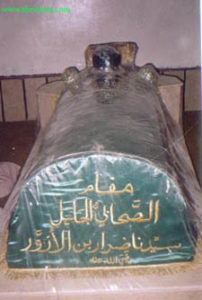
He also has a Mosque/maqam in Jordan.
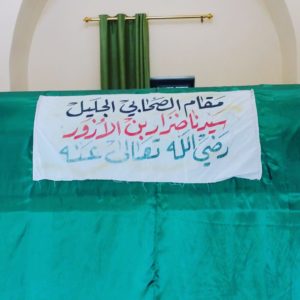

Refs
References: ZaSh, wiki
Photo f hismaqam in Damascus: yanabi.com
Damas Cultural Society © 2007
—-
More:
[gfh] Dirar b. al-Azwar al-Kindi, Khawla’s brother
buried in Bab Sharqi, Mahallat al-Jazma’
Bio: Ibn `Asakir al-Dimashqi al-Shafi`i al-Ash`ari

Ibn `Asakir al-Dimashqi al-Shafi`i al-Ash`ari
b. 499 – d. 571 in Damascus
radiya Allah anhu
﷽
English
`Ali ibn al-Hasan ibn Hibat Allah ibn `Abd Allah, Thiqat al-Din, Abu al-Qasim, known as Ibn `Asakir al-Dimashqi al-Shafi`i al-Ash`ari (499-571), the imam of hadith masters in his time and historian of Damascus.
Ibn al-Najjar said: “He is the imam of hadith scholars in his time and the chief leader in memorization, meticulous verification, thorough knowledge in the sciences of hadith, trustworthiness, nobility, and excellence in writing and beautiful recitation. He is the seal of this science.”
Born in a family imbued with knowledge, he began his scholarly training at the age of six, attending the fiqh gatherings of his older brother Sa’in al-Din Hibat Allah ibn al-Hasan (d. 563) and learned Arabic and grammar at the hand of his maternal grandfather Abu al-Mufaddal al-Qurashi. Two of his uncles and one of his brothers were successively in charge of the head judgeship in Damascus, Abu al-Ma`ali Muhammad ibn Yahya ibn `Ali al-Qurashi (d. 537), Abu al-Makarim Sultan ibn Yahya (d. 530), and Muhammad ibn al-Hasan.
By the time Ibn `Asakir reached puberty he already possessed hadith certifications from the scholars of Damascus, Baghdad, and Khurasan. At age twenty, after his father died, he travelled around the Islamic world in pursuit of hadith narrations and performed pilgrimage, returning to Damascus and travelling again on and off between 519 and 533, “alone but for the Godwariness he took as his companion,” hearing hadith from 1,300 male shaykhs and 80-odd female shaykhas in Baghdad, Mecca, Madina, Asbahan, Naysabur, Marw, Tibriz, Mihana, Bayhaq, Khusrujird, Bistam, Herat, Azerbaijan, Kufa, Hamadhan, Ray, Zanjan, Bushanj, Sarkhas, Simnan, Jarbadhqan, Mawsil and elsewhere.
After 533 he sat teaching hadith in a corner of the Umayyad mosque in Damascus, then in the Dar al-Sunna school (subsequenty renamed Dar al-Hadith) built for him by al-Malik al-`Adil Nur al-Din Mahmud ibn Zanki. He shunned all kinds of material possessions and turned down the office of head preacher, concentrating on teaching, writing, and worshipping. His most famous student was the sultan Salah al-Din al-Ayyubi, who attended his funeral behind the imam al-Qutb al-Naysaburi.
Ibn `Asakir was buried at the Bab al-Saghir cemetary, next to his father, near the grave of the Caliph Mu`awiya ibn Abi Sufyan.
Ibn `Asakir authored over a hundred books and epistles and narrated under five hundred hadith lessons. Among his larger works:
- Tarikh Dimasqh in eighty volumes.1 Ibn Khallikan said that it contains, like al-Tabari’s Tarikh al-Rusul wa al-Muluk, several books that can be read independently.
- Al-Muwafaqat `ala Shuyukh al-A’imma al-Thiqat in seventy-two volumes.
- `Awali Malik ibn Anas and its Dhayl in fifty volumes.
- Ghara’ib Malik in ten volumes.
- Al-Mu`jam listing only the names of his shaykhs, in twelve volumes.
- Manaqib al-Shubban in fifteen volumes.
- Books of “Immense Merits”: Fada’il Ashab al-Hadith in eleven volumes, Fadl al-Jumu`a, Fadl Quraysh, Fada’il al-Siddiq, Fada’il Makka, Fada’il al-Madina, Fada’il Bayt al-Muqaddas, Fada’il `Ashura’, Fada’il al-Muharram, Fada’il Sha`ban.
- Al-Ishraf `ala Ma`rifa al-Atraf.
- Akhbar al-Awza`i.
- Al-Musalsalat.
- Al-Suba`iyyat in seven volumes, listing narrations with chains containing only seven narrators up to the Prophet — Allah bless and greet him –.
- Tabyin Kadhib al-Muftari Fima Nusiba ila Abi al-Hasan al-Ash`ari, a defense of al-Ash`ari and his school which he divided into the following sections:
a) Genealogy of Abu al-Hasan al-Ash`ari
b) Prophetic hadiths that pertain to him
c) Al-Ash`ari’s renown for knowledge
d) His renown for piety and worship
e) His struggle against innovations and their proponents
f) Dreams that indicate his high standing
g) Five generations of his students [2] h) Those who attacked al-Ash`ari and his studentsHe concluded the book with the following lines of poetry:I have chosen a doctrine that in no way resembles innovation But which successors faithfully took from predecessors. Those who are impartial declare my doctrine sound While those who criticize it have abandoned impartiality.
- Yawm al-Mazid in three volumes.
- Bayan al-Wahm wa al-Takhlit fi Hadith al-Atit (“The Exposition of Error and Confusion in the Narration of the [Throne’s] Groaning”).[3]
- Arba`un Hadithan fi al-Jihad.
- Arba`un Hadithan `an Arba`ina Shaykhan min Arba`ina Madina.
Ibn `Asakir defined hadith in the following verse of poetry:
It explains the Book, and the Prophet only spoke on behalf of His Lord.
Ibn `Asakir’s son, Baha’ al-Din al-Qasim ibn `Ali, said:
My father was assiduous in congregational prayer and recitation of the Qur’an. He used to recite it once a week, concluding it on the day of Jum`a, and once a day in Ramadan at which time he entered seclusion (i`tikaf) at the Eastern minaret. He performed many supererogatory prayers, devotions, and invocations. He would spend the nights before the two `ids awake in prayer and supplications. He used to take account of himself for every passing moment.
Ibn al-Subki relates that the hadith master al-Mundhiri asked his shaykh Abu al-Hasan `Ali ibn al-Mufaddal al-Maqdisi: “Which of these four contemporary hadith masters is the greatest?” He said: “Name them.” Al-Mundhiri said: “Ibn `Asakir and Ibn Nasir?” He replied: “Ibn `Asakir.” Al-Mundhiri went on: “Ibn `Asakir and Abu al-`Ala’ [al-Hasan ibn Ahmad ibn al-Hasan al-Hamadhani]?” He said: “Ibn `Asakir.” Al-Mundhiri went on: “Ibn `Asakir and al-Silafi?” Al-Maqdisi said: “Al-Silafi (is) our shaykh. Al-Silafi (is) our shaykh.”[4]
Ibn Sasra narrated: “I used to rehearse with him the names of the masters he had met. One day I said to him: ‘I believe that our master never saw anyone like himself?’ He replied: ‘Do not say that. Allah said: {Therefore justify not yourselves} (53:32).’ I replied: ‘He also said: {Therefore of the bounty of your Lord be your discourse} (93:11).’ He replied: ‘In that case yes, if someone were to say that my eyes never saw my like, he would be correct.'” Al-Khatib Abu al-Fadl ibn Abi Nasr al-Tusi said: “We do not know anyone who truly deserves the title of hadith master in our time other than him.” Al-Dhahabi said: “I do not believe that Ibn `Asakir ever met anyone of his level in his entire life.” Ibn al-Subki added: “Nor anyone near his level.”
Main sources: al-Dhahabi, Siyar A`lam al-Nubala’ 15:254-262 #5129; Ibn al-Subki, Tabaqat al-Shafi`iyya al-Kubra 7:215-223 #918.
Notes:
[1] Dar al-Fikr in Damascus has published seventy of them to date in mid-1999.
[2] Translated at www.sunnah.org/aqida/tabyin_kadhib.htm
[3] See section entitled The “Groaning of the Throne” (p. 248).
[4] This could mean either that he considered al-Silafi the greater master, or that he implicitly admitted Ibn `Asakir’s superiority but expressed it in terms of the student’s requisite adab with his teacher. Ibn al-Subki noted that Ibn al-Sam`ani was superior to all of them except Ibn `Asakir, but that he was in far-off Merv, whereas the rest were in or near Egypt and Sham.
Blessings and peace on the Prophet, his Family, and all his Companions.
copyright As-Sunna Foundation of America
عربي
Books
تاريخ مدينة دمشق
Online database
Burial Place
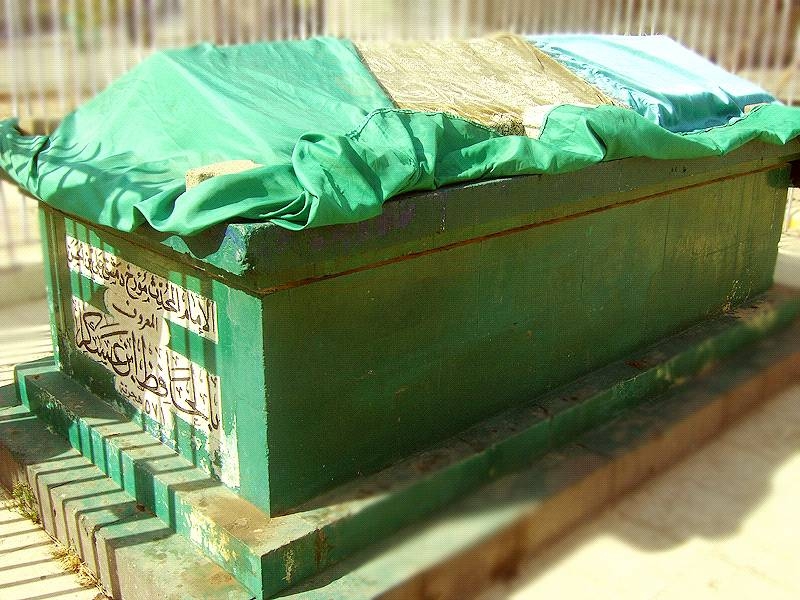 Buried in Bab Saghir in an enclosure opposite the entrance to the burial place of Sayyiduna Mu`awiya (radyaAllah ‘anhu).
Buried in Bab Saghir in an enclosure opposite the entrance to the burial place of Sayyiduna Mu`awiya (radyaAllah ‘anhu).
Refs
© Damas Cultural Society 2007 — Latest update:
Original site: damas-original.nur.nu
Bio: IMAM ABU AL-HASAN AL-ASH`ARI

Imam Abu Al-Hasan Al-Ash`ari
b. 1244 – d. 1306 H. in Damascus
radiya Allah anhu
Bio: Imam Abu Hanifa

Imam Abu Hanifa
الأمام الأعظم أبو حنيفة النعمان بن ثابت الكوفيّ
d. 150 in Baghdad
radiya Allah anhu
.
English
The Greatest Imam Abu Hanifa
By Dr. G.F. Haddad
Al-Nu`man ibn Thabit al-Taymi, al-Imam Abu Hanifa (d. 150), called “The Imam” by Abu Dawud, and “The Imam, one of those who have reached the sky” by Ibn Hajar, he is known in the Islamic world as “The Greatest Imam” (al-imâm al-a`zam) and his school has the largest number of followers among the four schools of Ahl al-Sunna. He is the first of the four mujtahid imams and the only Successor (tâbi`i) among them, having seen the Companions Anas ibn Malik, `Abd Allah ibn Abi Awfa, Sahl ibn Sa`d al-Sa`idi, Abu al-Tufayl, and `Amir ibn Wathila.
Abu Hanifa is the first in Islam to organize the writing of fiqh under sub-headings embracing the whole of the Law, beginning with purity (tahara) followed by prayer (sala), an order which was retained by all subsequent scholars such as Malik, Shafi`i, Abu Dawud, Bukhari, Muslim, Tirmidhi, and others. All these and their followers are indebted to him and give him a share of their reward because he was the first to open that road for them, according to the hadith of the Prophet: “He who starts something good in Islam has its reward and the reward of those who practice it until the Day of Judgement, without lessening in the least the reward of those who practice it. The one who starts something bad in Islam will incur its punishment and the punishment of all those who practice it until the Day of Judgement without lessening their punishment in the least.” Al-Shafi`i referred to this when he said: “People are all the children of Abu Hanifa in fiqh, of Ibn Ishaq in history, of Malik in hadith, and of Muqatil in tafsîr.”
Al-Khatib narrated from Abu Hanifa’s student Abu Nu`aym that the latter said: “Muslims should make du`a to Allah on behalf of Abu Hanifa in their prayers, because the Sunan and the fiqh were preserved for them through him. Al-Dhahabi wrote one volume on the life of each of the other three great Imams and said: “The account of Abu Hanifa’s life requires two volumes.” His son Hammad said as he washed his father’s body for burial: “May Allah have mercy on you! You have exhausted whoever tries to catch up with you.”
Abu Hanifa was scrupulously pious and refused Ibn Hubayra’s offer of a judgeship even when the latter had him whipped. Like al-Bukhari and al-Shafi`i, he used to make 60 complete recitations (khatma) of Qur’an every Ramadan: one in the day, one in the night, besides his teaching and other duties. Ibrahim ibn Rustum al-Marwazi said: “Four are the Imams that recited the entire Qur’an in a single rak`a: `Uthman ibn `Affan, Tamim al-Dari, Sa`id ibn Jubayr, and Abu Hanifa.” Ibn al-Mubarak said: “Abu Hanifa for a long time would pray all five prayers with a single ablution.”
Al-Suyuti relates in Tabyid al-Sahifa that a certain visitor came to observe Abu Hanifa and saw him all day long in the mosque, teaching relentlessly, answering every question from both the scholars and the common people, not stopping except to pray, then standing at home in prayer when people were asleep, hardly ever eating or sleeping, and yet the most handsome and gracious of people, always alert and never tired, day after day for a long time, so that in the end the visitor said: “I became convinced that this was not an ordinary matter, but wilâya (Friendship with Allah).”
Al-Shafi`i said: “Knowledge revolves around three men: Malik, al-Layth, and Ibn `Uyayna.” Al-Dhahabi commented: “Rather, it revolves also around al-Awza`i, al-Thawri, Ma`mar, Abu Hanifa, Shu`ba, and the two Hammads [ibn Zayd and ibn Salama].”
Sufyan al-Thawri praised Abu Hanifa when he said: “We were in front of Abu Hanifa like small birds in front of the falcon,” and Sufyan stood up for him when Abu Hanifa visited him after his brother’s death, and he said: “This man holds a high rank in knowledge, and if I did not stand up for his science I would stand up for his age, and if not for his age then for his Godwariness (wara`), and if not for his Godwariness then for his jurisprudence (fiqh).” Ibn al-Mubarak praised Abu Hanifa and called him a sign of Allah. Both Ibn al-Mubarak and Sufyan al-Thawri said: “Abu Hanifa was in his time the most knowledgeable of all people on earth.” Ibn Hajar also related that Ibn al-Mubarak said: “If Allah had not rescued me with Abu Hanifa and Sufyan [al-Thawri] I would have been like the rest of the common people.” Dhahabi relates it as: “I would have been an innovator.”
An example of Abu Hanifa’s perspicuity in inferring legal rulings from source-texts is his reading of the following hadith:
The Prophet said: “Your life in comparison to the lifetime of past nations is like the period between the time of the mid-afternoon prayer (‘asr) and sunset. Your example and the example of the Jews and Christians is that of a man who employed laborers and said to them: ‘Who will work for me until mid-day for one qirât (a unit of measure, part of a dinar) each?’ The Jews worked until mid-day for one qirât each. Then the man said: ‘Who will work for me from mid-day until the ‘asr prayer for one qirât each?’ The Christians worked from mid-day until the ‘asr prayer for one qirât each. Then the man said: ‘Who will work for me from the `asr prayer until the maghrib prayer for two qirât each?’ And that, in truth, is all of you. In truth, you have double the wages. The Jews and the Christians became angry and said: ‘We did more labor but took less wages.’ But Allah said: ‘Have I wronged you in any of your rights?’ They replied no. Then He said: ‘This is My Blessing which I give to whom I wish.’”
It was deduced from the phrase “We did more labor” that the time of mid-day to `asr must always be longer than that between `asr and maghrib. This is confirmed by authentic reports whereby:
The Prophet hastened to pray zuhr and delayed praying `asr.
The Prophet said: “May Allah have mercy on someone who prays four rak`as before `asr.
`Ali delayed praying `asr until shortly before the sun changed, and he reprimanded the mu’adhdhin who was hurrying him with the words: “He is trying to teach us the Sunna!”
Ibrahim al-Nakha`i said: “Those that came before you used to hasten more than you to pray zuhr and delay more than you in praying `asr.” Al-Tahanawi said: “Those that came before you” are the Companions.
Ibn Mas`ud delayed praying `asr.
Sufyan al-Thawri, Abu Hanifa, and his two companions Muhammad ibn a-Hasan and Abu Yusuf therefore considered it better to lengthen the time between zuhr and `asr by delaying the latter prayer as long as the sun did not begin to redden, while the majority of the authorities considered that praying `asr early is better, on the basis of other sound evidence to that effect.
Like every Friend of Allah, Abu Hanifa had his enemies. `Abdan said that he heard Ibn al-Mubarak say: “If you hear them mention Abu Hanifa derogatively then they are mentioning me derogatively. In truth I fear for them Allah’s displeasure.” Authentically related from Bishr al-Hafi is the statement: “No-one criticizes Abu Hanifa except an envier or an ignoramus.” Hamid ibn Adam al-Marwazi said: I heard Ibn al-Mubarak say: “I never saw anyone more fearful of Allah than Abu Hanifa, even on trial under the whip and through money and property.” Abu Mu`awiya al-Darir said: “Love of Abu Hanifa is part of the Sunna.”
Abū Hanīfa’s Foresight
by GF Haddad
PDF from http://www.sunnah.org/history/Scholars/AbuHanifasForesight.pdf
عربي
Sagacity of Imam Abu Hanifah
Sagacity of Imam Abu Hanifah
A man by the name of Ad-Dahhak ibn Qays al-Kharji, who rebelled during the time of the Ummayyads, entered the mosque in Kufa and told Imam Abu Hanifa, “Repent!”
“From what?” asked Abu Hanifa.
He answered, “From your having permitted arbitration.”
“Will you kill me or debate with me?” asked the Imam.
“I will debate with you.”
“And if we disagree on anything in the debate, who will decide between us?”
“I will accept whomever you wish.”
“Sit and judge between us if we disagree,” Abu Hanifa said to one of ad-Dahhak’s companions.
“Are you content for this one to decide between us?” asked Abu Hanifa to ad-Dahhak.
“Yes”
“You have allowed arbitration, so desist.”
Notes & Refs
al-Khatib, Tarikh Baghdad 13:324-356;
al-Dhahabi, Manaqib Abi Hanifa 22-36 and Tabaqat al-Huffaz 1:168;
Ibn Hajar, Tahdhib al-Tahdhib 10:450;
Ibn Kathir, al-Bidaya wa al-Nihaya 10:114;
al-Suyuti, Tabyid al-Sahifa p. 94-95;
al-Haytami, al-Khayrat al-Hisan.
copyright As-Sunna Foundation of America
© Damas Cultural Society 2007 — Latest update:
Original site: damas-original.nur.nu
Bio: Imam al-Awza´i

`Abd al-Rahman ibn `Amr ibn Yuhmad Abu `Amr al-Awza`i
الإمام عبد الرحمن الأوزاعي
b. 88 – d. 158 H. in Beirut, Libanon (707 – 744 CE) tabi´i
radiya Allah anhu
﷽
English
Al-Awza`i
By Dr. G.F. Haddad
`Abd al-Rahman ibn `Amr ibn Yuhmad Abu `Amr al-Awza`i (88-158), Shaykh al-Islam, the Wise Scholar of the People of Sham, one of the mujtahid imams of the Salaf along with the Four Imams, Sufyan al-Thawri, al-Tabari, Dawud al-Zahiri and others, the first – with Ibn Jurayj and Abu Hanifa – to compile the Sunna of the Prophet — Allah bless and greet him — and the Companions under fiqh subheadings. Born orphaned and poor in Ba`labak and raised in al-Kark in the Bekaa valley, he came to live in the area known as – and populated by – “the variegated tribes” (al-Awza`) in Damascus then moved to Beirut where he remained garrisoned until his death, his fame having spread to the entire Islamic world of his time. One of those who combined assiduous worship with science and the affirmation of truth, he is considered a Proof in himself (hujja) as a narrator, known for his superlative understanding of the Law, great erudition, and piety. Al-Shafi`i said: “I never saw a man whose fiqh resembled his hadith more than al-Awza`i.”1
He narrated from a host of Tabi`in, among them `Ata’ ibn Abi Rabah, Abu Ja`far al-Baqir, `Amr ibn Shu`ayb, Makhul – whom he surpassed in knowledge, – Qatada, Rabi`a ibn Yazid al-Qasir, Bilal ibn Sa`d, al-Zuhri, Yahya ibn Abi Kathir – his first shaykh,- `Abd al-Rahman ibn al-Qasim, `Ata’ al-Khurasani, `Ikrima, `Alqama, Ibn al-Munkadir, al-Walid ibn Hisham, Muhammad ibn Sirin, Nafi` – Ibn `Umar’s freedman – and many others. From him narrated his two shaykhs al-Zuhri and Yahya ibn Abi Kathir, Shu`ba, al-Thawri, Malik, Sa`id ibn `Abd al-`Aziz, Isma`il ibn `Ayyash, Baqiyya, Yahya al-Qattan, and many others.
Al-`Abbas ibn al-Walid said: I never saw my father admire anything in the world as much as he admired al-Awza`i. He used to exclaim about him: “Glory to You! You do what You wish.” O my son! Kings are powerless to discipline themselves and their own children the way that al-Awza`i disciplined himself. I never in my life heard him say an excellent word except the listener was bound to observe that it applied to him. Nor did I ever see him laugh without restraint. Whenever he addressed the subject of our return to our Maker, I would say to myself: I wonder, is there one heart in this gathering that is not weeping?
Al-Hiql said: “Al-Awza`i gave replies covering about seventy thousand issues.” `Abd al-Rahman ibn Mahdi said: “The People (al-nas) in their time were four: Hammad ibn Zayd in al-Basra, al-Thawri in al-Kufa, Malik in al-Hijaz, and al-Awza`i in al-Sham.”2 Isma`il ibn `Ayyash said: “I heard people say, in the year 140, that in our day the wise scholar of the Umma is al-Awza`i.” When the latter came to Mecca, Sufyan al-Thawri walked ahead of him shouting: “Open the way for the Shaykh!” Malik compared the two saying: “One of them [Sufyan] is more knowledgeable than the other, but is not fit to be the Imam [i.e. the Caliph], while the other [al-Awza`i] is.” This was also the opinion of al-Fazari, `Ali ibn Bakkar, and Ibn al-Mubarak.
He was fearless in telling the truth to princes. After massacring the Banu Umayya, the harsh king `Abd Allah ibn `Ali – al-Saffah’s uncle – summoned him and asked him in front of his court: “What is your opinion of what we have done?” Al-Awza`i related: “I thought to myself and decided to tell him the truth, bracing for certain death. I narrated to him the hadith: `Actions are only according to intentions.’3 He said: `What do you say about our killing the people of that dynasty?’ I narrated to him the hadith: `Killing a Muslim is forbidden except in three cases: adultery after marriage, apostasy after Islam, and unlawful manslaughter.’4 He continued: `Tell me about the caliphate, is it not our inheritance as stipulated by the Prophet — Allah bless and greet him?’ I replied: `Had this been the case, `Ali – Allah be well-pleased with him – would have never left anyone come before him.’ He said: `But what do we say about the treasury of the Banu Umayya?’ I replied: `If they were licit to them, they are illicit to you, and if they were illicit to them, they are even more illicit to you.'”
Al-Awza`i did not rise from his place of morning prayer until sunrise, and the sun did not pass the zenith except he was seen standing in prayer. Al-Walid ibn Mazyad said: “No-one surpassed him in intensity of worship.”Among his sayings:
* Marwan al-Tatari said that al-Awza`i said: “Whoever stands in prayer at night at length, Allah shall make the station of the Day of Resurrection easy for him.”
* Al-Walid ibn Muslim and `Abd Allah ibn al-Mubarak related that al-Awza`i said: “This science was noble, men would transmit it to one another, but when it spread to books, those other than its rightful custodians became involved with it.”5
* “Whoever holds on to the rare and unusual positions of the scholars has left Islam.” This is similar to Ibn `Abd al-Salam’s saying: “There is no good in one who over-maneuvers (yatahayyal) so as to impose his doctrine despite its weakness and the fact that his evidence is far removed from the truth – whether he interprets the Sunna, or the Consensus, or the Book – standing on bases that are neither right nor true, through corrupt figurative interpretations and rare responses.”6
* “The Book stands in greater need to the Sunna than the Sunna to the Book.” Ibn `Abd al-Barr said: “That is because the Sunna expounds the meaning of the Book (and not vice versa).”7
* Al-Walid ibn Mazyad said that al-Awza`i, asked about humility (khushu`) in prayer, replied: “Downcast gaze, lowering the wing of submission, and softness of heart which is sorrow and dread.” He also said: “I saw al-Awza`i, he was like a blind man due to his humility.”
* Al-Walid heard al-Awza`i define the naïve (al-ablah) as “he who is in blind ignorance of evil but acutely discerning of goodness.”
* “Whoever remembers death much, a little suffices him for livelihood; and whoever realizes that his utterances are counted as deeds, his speech becomes spare.”
* `Abd Allah ibn Ahmad narrated from al-Hasan ibn `Abd al-`Aziz from `Amr ibn Abi Salama al-Tinnisi that al-Awza`i said: “I saw myself as if carried up by two angels who camped me in front of the Lord of Power and Might. He said to me: `Are you my servant `Abd al-Rahman who commands good deeds?’ I replied: `By Your Power and Might! You know best.’ Then they descended again and brought me back where I first was.”
Among al-Awza`i’s notable rulings is that the thigh is part of a man’s legal nakedness in the mosque, but not in the bath.8
Muhammad ibn `Abd al-Rahman al-Sulami said: “I saw al-Awza`i, he was of above-average build, slim, somewhat swarthy, and he used henna.” He used to wear a round turban without a hanging extremity (`adhaba). Al-Dhahabi said: “In addition to his brilliance in the science and his foremost rank in works, he was also a master in the art of writing letters.” Four communities attended his funeral in Beirut: the Muslims carried his bier, followed by the Jews, the Christians, and the Copts. Yazid ibn Madh`ur said: “I saw al-Awza`i in my sleep and asked him: `Show me a level by which to draw near to Allah.’ He replied: `I did not see a level higher than that of the wise scholars of knowledge (al-`ulama’), and, after it, that of the grief-stricken (al-mahzunin).'” SAN 7:86-104 #1049.
_______________________
1 A reference to al-Awza`i’s faithful application of his knowledge in his life.
2 This is a notable example of the use of al-nas to mean the major ulamas.
3 Narrated from `Umar by Bukhari and Muslim.
4 Narrated from Ibn Mas`ud by Bukhari, Muslim, and in the Four Sunan; from `Uthman by al-Tirmidhi (hasan), al-Nasa’i, Ibn Majah, Ahmad, al-Hakim (4:350), al-Shafi`i in his Musnad, al-Bazzar in his Musnad; and from `A’isha by Abu Dawud. See al-Bayhaqi’s Kitab al-Murtadd in Ma`rifa al-Sunan (12:237-258).
5 This statement refers to the books which are passed on for circulation as in modern times, not to those used by the early narrators as mnemonic records when narrating. It is established that early hadith narrators did not narrate except from record, as demonstrated by M.M. Azami and others. ‘Abd Allah ibn Ahmad ibn Hanbal said: “I never saw my father narrate except from a book, save less than a hundred hadiths.” In al-Dhahabi, Siyar A`lam al-Nubala’ (9:457). The best source on the proof-texts for this fact is al-Khatib al-Baghdadi’s book Taqyid al-‘Ilm (“The Tethering of Knowledge”). This title is taken from Anas’s saying: “Tether knowledge with writing” (qayyidu al-‘ilma bi al-kitab). Anas also said: “We would not consider as knowledge the knowledge of those who did not write down their knowledge.” Taqyid (p. 96-97). See also al-Hakim al-Tirmidhi’s chapter entitled “Writing is the means to tether knowledge and preserve it from oblivion” in his Nawadir al-Usul (p. 39-41).
6 Ibn `Abd al-Salam, Al-Qawa`id al-Sughra (p. 144).
7 Narrated by al-Darimi and others and cited by Ibn `Abd al-Barr in Jami` Bayan al-`Ilm (2:1193-1194 #2351). and al-Shatibi in al-Muwafaqat (Salafiyya ed. 1343 4:10).
8 The rulings of the Four Schools agree that the definition of “nakedness” (`awra) for a man is all that is above the knees and below the navel front and back whether in public or private. Among the proofs for this is the Prophet’s — Allah bless and greet him — saying: “The [man’s] thigh is nakedness.” Narrated from Jarhad al-Aslami, `Ali, and Muhammad ibn Jahsh – with three sound chains according to al-Arna’ut – by Abu Dawud, Ibn Majah, Ahmad, Malik, al-Hakim (4:180-181), Abu Ya`la in his Musnad (#331), al-Tahawi in Sharh Mushkil al-Athar (4:401-406 #1697, #1699, #1700, #1704), al-Baghawi in Sharh al-Sunna (9:21-22), Ibn Hibban in his Sahih (4:609-611), and others. Al-Tahawi said in Sharh Ma`ani al-Athar (1:474): “Mass-narrated, sound reports from the Prophet — Allah bless and greet him — have reached us that the thigh is nakedness.” Al-Kattani cited it in Nazm al-Mutanathir.
Copyright As-Sunna Foundation of America
Türkçe
عربي
الإمام عبد الرحمن الأوزاعي
الإمام الحافظ إمام بيروت وسائر الشَّام والمغرب والأندلُس أبو عمرو عبدُ الرحمٰن بن عمرو بن يُحمد الأوزاعي، فقيه ومُحدّث وأحد تابعي التابعين وإمام أهل الشام في زمانه. أُضيف إلى ألقابه لقب إمام العيش المُشترك في لُبنان في العصر الحديث، لِما مثَّلته مواقفه في عصره من تسامح مع المسيحيين واليهود من أهل الشَّام، ولُقِّب بِشفيع النصارى لِموقفه الحازم في مُواجهة والي الشَّام والخليفة العبَّاسي أبو جعفر المنصور، اللذان عزما على إجلاء أهالي جبل لبنان المسيحيين بعد أن ثارت جماعة منهم وتمرَّدت على العبَّاسيين وشقَّت عصا الطاعة، فرفض الأوزاعي إجلاء هؤلاء كُلُّهم طالما أنَّ فئةً منهم فقط كانت من ثارت، ووقف بوجه الخِلافة بِعناد مُذكرًا أهل السُلطة بالعدل بين الناس وأنَّ خطأ فئة لا يستوجب مُعاقبة الجماعة، فأُبطل هذا القرار، وسلم أهالي جبل لُبنان من تعسُّف السُلطة، وحفظوا لِلأوزاعي جميله.[1]
على الأرجح وُلد الأوزاعي في بعلبك، وعاش فترة من صباه في قرية الكرك البقاعيَّة يتيمًا فقيرًا، ثُمَّ انتقل مع أُمِّه إلى بيروت. وكان قبل ذلك قد عاش مع عائلته في دمشق، وتنقَّل بين حلب وحماة وقنسرين وسواها. أُطلق عليه اسم «الأوزاعي» نسبةً إلى «الأوزاع» وهي قبيلة يمنيَّة حميريَّة من بطن ذي الكلاع من قحطان. نزل أفرادٌ منها في دمشق قرب باب الفراديس، وقد أُطلق على المنطقة التي نزلوا فيها اسم قرية «الأوزاع». لم يذكر المُؤرخون والفُقهاء والعُلماء شيئًا عن والد الإمام الأوزاعي باستثناء ما أشار إليه الإمام نفسه، ولا عن والدته أو أخواله، غير أنَّهم أشاروا إلى أنَّ كان له عمٌّ واحد، والثَّابت أنَّهُ تزوَّج أكثر من مرَّة، ورُزق بِثلاث بنات وصبيٍّ واحد، وكان له حفيدين من بناته بِحسب الظاهر.[2]
عاش الأوزاعي في عهدين سياسيين هامين، فشهد نهاية الدولة الأموية وقيام الدولة العباسية، وعاصر من الخُلفاء: الوليد بن عبد الملك، وسليمان بن عبد الملك، وعمر بن عبد العزيز، ويزيد بن عبد الملك، وهشام بن عبد الملك، والوليد بن يزيد، ويزيد بن الوليد، وإبراهيم بن الوليد، ومروان بن محمد، وأبو العباس السفاح، وأبو جعفر المنصور. وكانت الفترة التي عاشها الإمام الأوزاعي تزخر بِالعلم والعُلماء والفُقهاء والقُرَّاء والمُحدثين، ومن أبرز عُلماء تلك الفترة الأئمَّة: مالك بن أنس، وجعفر الصادق، وسفيان الثوري، والحسن البصري، ومحمد بن سيرين، وأبو حنيفة النعمان، والليث بن سعد، وسواهم. وكان الأوزاعي من المُتفوقين علميًّا وفقهيًّا وجُرأةً على الكثير من عُلماء عصره، وقد أفتى وهو في الثالثة عشرة من عمره في مسائل فقهيَّة، بينما أفتى وهو في السابعة عشرة من عمره في مسائل عقائديَّة. وكان الأوزاعي مؤمنًا أشد الإيمان بالقاعدة الإسلامية «الرحلة في طلب العلم»، لذا تنقل في مُدن الشَّام وفي اليمامة والبصرة والمدينة المنورة وبيت المقدس، وحجَّ أكثر من مرة، لِذلك فقد تعمَّق في العُلوم الدينيَّة والشرعيَّة بِشكلٍ لافتٍ لِلنظر. أمَّا فيما يختص بالقضاء فقد رفض الأوزاعي منصب القضاء في العصرين الأُموي والعبَّاسي، فلمَّا وُلي زمن يزيد بن الوليد جلس مجلسًا واحدًا ثُمَّ استعفى، إيمانًا منه بِأنَّ القضاء مسؤوليَّة إسلاميَّة ضخمة لا يُمكن لِأي إنسان أن يتحمَّل وزر مسؤوليَّتها.[3]
وكان الأوزاعي من كبار الأئمَّة المُدافعين عن الإسلام والسُنَّة النبويَّة، لا سيَّما في فترة تزايد البدع والجدل والانحراف عن القُرآن والسُنَّة،[4] كما كان حريصًا على الجهاد والرباط والدفاع عن المظلومين وعن الحق، وكان استقراره في ثغر بيروت بدافع الرباط ورد الاعتداءات عن ديار الإسلام، وكانت الفترة التي قضاها في بيروت أكثر سني حياته المُنتجة والغزيرة، ففيها طوَّر مذهبه، وانتشر في كافَّة أنحاء الشَّام وانتقل إلى المغرب والأندلُس، لِيكون خامس مذاهب أهل السنة والجماعة، لكن لم يُكتب لمذهبه البقاء، فاندثر بعد أن لم يهتم تلامذته بتدوينه والحفاظ عليه، فحل مكانه المذهب الحنفي والشافعي في الشَّام والمالكي في المغرب والأندلس. توفي الأوزاعي في بيروت سنة 157 هـ، وكانت جنازته كبيرة وقيل أن من شارك فيها من المسيحيين واليهود كان أكثر ممن شارك من المسلمين، وأنَّ قسمًا من هؤلاء أشهر إسلامه يومها. دُفن الأوزاعي في قرية «حنتوس» جنوب بيروت، وشُيِّد على قبره مقام ومسجد عُرف بِمسجد الإمام الأوزاعي، ومع مُرور السنوات تغيَّر اسم القرية حتَّى أصبحت تُعرف بـ«الأوزاعي»، وشكَّلت جُزء من بيروت الكُبرى مع مرور الزمن.
تقديرًا لإنجازات الإمام الأوزاعي ورمزيَّته في بيروت، أُنشأت كُليَّة لِلدراسات الإسلاميَّة في المدينة سُميت على اسمه: كُليَّة الإمام الأوزاعي لِلدراسات الإسلاميَّة، وتمَّ إصدار طابع بريدي تذكاري سنة 2009م عن وزارة الاتصالات في لُبنان بعد موافقة مجلس الوزراء، وتبنَّت بلديَّة بيروت اقتراح المؤرخ الدكتور حسان حلاق بتسمية ساحة سوق الطويلة في وسط بيروت التجاري بساحة الإمام الأوزاعي، وبإعادة ترميم زاويته القائمة في ذات الساحة منذ عصره حتَّى اليوم.
Burial Place
Refs
Bio: Imam Al-Ghazali

Imam Al-Ghazali
ألإمام أبو حامد الغزاليb. 450 H. in Tus – d.505 H. in Tus
Abu Hamid Muhammad b. Muhammad al-Tusi al-Shafi`i
radiya Allah anhu
Bio: Imam al-Jazuli

Sayyidi Imam Muhammad b. Sulayman al-Jazuli al-Hasani al-Shadhili
الإمام الجزولي – أبو عبد الله محمد الجُزُولي السملالي الحسني الشاذلي
d. 869/870/873 H. in Marrakash
qaddasa Allah sirrahu
Bio: Imam Al-Junayd Al-Baghdadi

Abū ‘l-Qāsim al-Junayd bin Muhammad al-Baghdadi
(d. 297 H. in Baghdad)
radiya Allah anhu
Bio: Imam Sharaf al-Din al-Busiri

Imam Sharaf al-Din al-Busiri
d. 684 H. in Alexandria
radiya Allah anhu
Bio: Nur al-Din b. Zanki

Nur al-Din b. Zanki
b. 511 – d. 579 in Daamascus
radiya Allah anhu
– السلطان أبو القاسم نور الدين محمود ين أبي سعيد(أبو سعد) زنكي بن سيف الدين –
Just ruler of Damscus, first in history ot build a Dar al-hadith, gave many books as waqf, built schools and mosques and institueted many awqaf, loved and honored the pple of din; strong in warfare, a good archer, he would only consume out of wealth he gained by buisineness or spoils of war according to what the `ulema deemd lawful; he forbade wide under his rule, known for his justice and rightousness, rebuilt the city walls and fortresses of all Sham: Aleppo and Hums and Hama and Damascus and other places; build several hospitals, the most famous one in Damascus, which was institueted as waqf, and where rich and poor were attended to; and he made Daria (a village in the Ghuta west of Damascus) a waqf for poor Muslims. [Ziarat al-Sham p. 27-28, quoting Ibn Khaldun]
He was buried in the city wall of Damascus, later his remains were moved to a madrasa he had built for the Hanafis on the Westersn side of (الخواصين أو الخوامين، معروف الآن بسعق الخياطين وكان يعرف بسوق الآخصاصين)ـ
[Ziarat al-Sham p. 29]
© Damas Cultural Society 2007 — Latest update:
Original site: damas-original.nur.nu
Bio: Sh-. `Abd al-Rahman al-`Attar al-Madani

Sayyidi `Abd al-Rahman al-`Attar al-Madani al-Hasani al-Idrisi
(الشيخ عبد الرجمن المدني العَطَّار الحسني (الملقب بالزَّيات
d. around 600 H. in Madina al-Munawwara
radiya Allah anhu
Bio: Sh. Abul Hassan ´Ali ibn Hirzihum

Sayyidi Abul Hassan Ali ibn Hirzihum
d. 544 H. (1129 CE) in Fas
qaddasa Allah sirrahu
Teacher of Sayyiduna Shaykh Abu Madyan al-Ghawth
Bio: Sh. Ahmad al-Tabrizi al-Hanafi

Ahmad al-Tabrizi al-Hanafi
d. 735 in Damascus, Kafar Susa
أحمد بن عبد الكريم بن عبد الصمد التبريزي الحنفي
radiya Allah anhu
Great Hanafi scholar, who used to witness (i.e. veryfy legal writings) in front of al-Madrasa al-Masmariyya in Qaymariya. Died in Kafar Susa and was buried there. [ZaSh p. 41]
Damas Cultural Society © 2007
Bio: Sh. Ahmad b. Badr al-Din al-Hanafi

Shaykh Ahmad b. Badr al-Din al-Hanafi
d. 934
أحمد بن بدر الدين الحنفي
radiya Allah anhu
Buried in the Hamriyyah graveyard
– بمحلة الشويكة – [ZaSh p. 41]
Reference: Damas Cultural Society © 2007
Bio: Sh. Badr al-Din al-Hasani

Shaykh Badr al-Din al-Hasani
محدث الشام الأكبرالشيخ محمد بدر الدين بن يوسف الحسني المغربي الاصل الدمشقي
b. 1267 – d. 1354 H in Damascus (1850-1935 CE)
qaddasa Allah sirrahu
.
“The muhaddith of Sham” – one of the last great memorisers of hadith. This Hanafi master had a photographic memory and used it to his utmost ability. He lived a life of ascetic worship and teaching, with a handful of students receiving his full devotion.
Bio English
One of the great scholars, Badruddin Al-Hasani (who was a master of hadith), from the city of Damascus, who died in this age, at every ‘Eid, he would go out, and he would give his students charity from his own pocket, and there were places, particularly in the colonialism era, where there were a lot of women that were impoverished and forced into prostitution to support themselves, and he would tell his student to give those prostitutes charity, and he would say to them, “Tell them that Badruddin Al-Hasani asked you to make du’ah (supplication) for him.” And those women would weep when they heard that: “Who are we to make du’ah for Badruddin Al-Hasani?.” There were people who repented because of that act.
The following are quoted from Al Durar Al Lu’lu’iyyah by Shaikh Mahmood al Rankoosi (pp. 9, 13, 28) who was his special student for the last twelve years of his life:
“He knew Saheeh Muslim and Bukhaari by heart, including individual chains of narrators and their biographies. It is not improbable that he also knew by heart their commentaries from “Fath Al Baari”, al `Ayni and al Nawawi.
Egypt’s Mufti Shaikh Muhammad Bakheet said: “If he was with us in Egypt, (out of respect) scholars would carry him over their shoulders.”
Shaikh Muhammad al Qaayaati said:”He is among the rarities of this age… We were present one night when he was reciting Saheeh Al Bukhaari. He recited more than one hour, discussing topics and explaining Hadeeth by heart.”
The great Hadeeth scholar Abdu’l Waasi` al Yamaani said: “I have heard teachers and preachers in numerous countries but I have never seen anybody similar to him concerning his expertise in all Sciences.”
A scholar from India said in a long biography: “He is the Qutb -pivot, pillar- of our time and the Mujaddid -renovator of religion- of our age.”
Shaikhu’l Islam in Istanbul, Musa Kaazim Afandi said: “He is the Qutb of the Muslim world.”
Al Sayyid al Kabeer al Kittaani al Maghribi said: “There has been no one comparable to him since five hundred years.”
Experts in engineering and mathematics would often attend his lessons and concede his superiority in these sciences saying: “We spent all our life learning but did not reach his level.”
عربي
Portraits
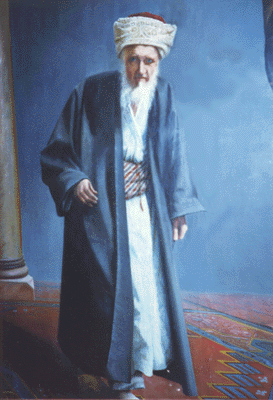
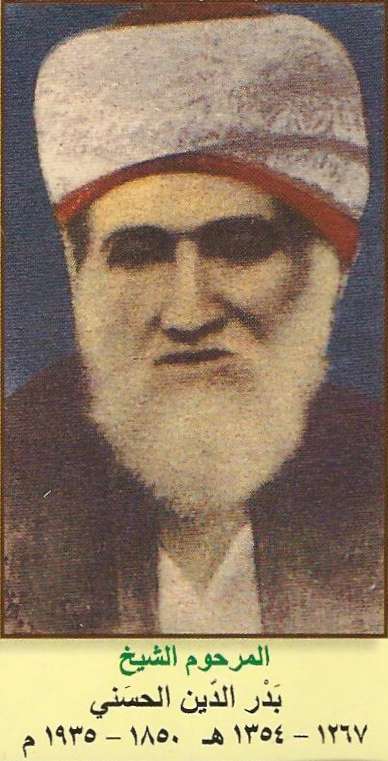
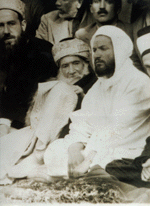
Sheikh Badru al-Din al-Hasani in the center of the picture, using his particular turban, with Sheikh `Ayun Suwayd
Burial Place
Buried outside the Maqbara Bab Saghir. A modern mosque with an institute is erected next to his grave. With him is buried his son Sheikh Yusuf al-Hasani (d. 1279 H), who succeded him as a head of Dar al-Hadith.
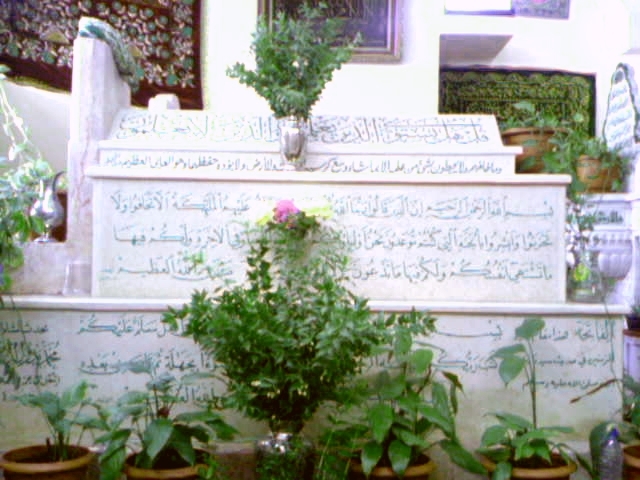
Tomb of Sheikh Badru al-Din al-Hasani
Photo: JK/Ziarat 2006
Ref's
– Depending on Allah, Zaytuna Institute Paper
– Dar al-Hadith
– Hanbali Text Society
– Damas Cultural Society 2006
© Damas Cultural Society 2006
Bio: Sh. Muhammad Abul Yusr `Abidin al-Husayni

Al-Sayyid al-Sheikh Muhammad Abul Yusr `Abidin al-Husayni
الشريف الشيخ محمد أبو اليسر بن محمد عابدين الحسيني
b. 1307 – d. 1401 H. in Damascus (1889–1981 CE)
radiya Allah anhu
Bio: Sh. Muhammad Amin `Abidin (Ibn `Abidin)

Al-Sayyid al-Sheikh Muhammad Amin`Abidin al-Hanafi al-Husayni
سيدي الشيخ محمد أمين بن عمر بن عبد العزيز عابدين الحنفي الحسيني الدمشقي
b. – d. 1252 H. in Damascus
radiya Allah anhu
.
Author the Hashya, known as Ibn ´Abidin
Abidin family tree and lineage
| `Umar (d. 1237) | |
||
| | Muhammad Amin (d. 1252 H.) sahib al-Hashia | `Ala al-Din (d. 1306 H.) |
| `Abd al-Ghani | Ahmad (d. 1307 H.) | Muhammad Abu Khayr (d. 1345 H.) | Muhammad Abul Yusr (d. 1401 H.) |
|
Lineage of `Umar ‘Abidin:
He was `Umar
b. `Abd al-`Aziz b. Ahmad
b. `Abd al-Rahim
b. Muhammad Salih al-Din (known as Ibn `Abidin because of his rightousness)
b. Najm al-Din b. Muhammad
b. Kamal b. Taqi al-Din (al-mudarris)
b. Mustafa b. Husayn b. Rahmatu Allahal-Thani b. Qasim
b. Hasan
b. Isma’il (the first of them who came to Damascus, became the leader of the guild of ashraf in 330 H. ),
b. Husayn al-Thalith,
b. Ahmad b. al-Khamis
b. Isma’il al-Thani
b. Muhammad
b. Isma’il al-A`raj
b. al-Imam Ja`far al-Sadiq
b. al-Imam Muhammad al-Baqir
b. al-Imam `Ali Zayn al-`Abidin
b. al-Imam al-Husayn
b. Sayyidina `Ali & Sayyidatina Fatima radia Allah `anhum.
Burial Place
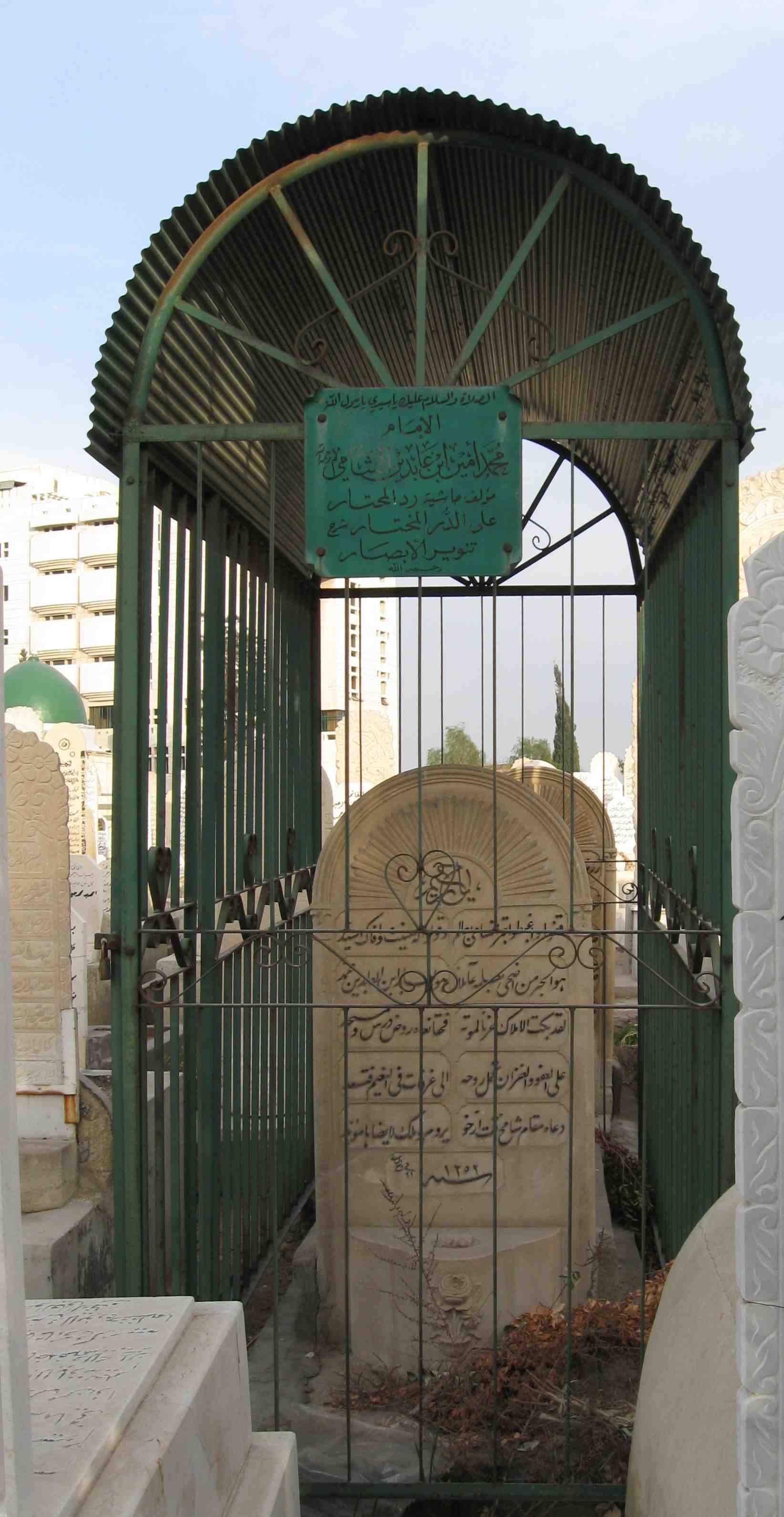 Burial place of Sheikh Muhammad Amin ‘Abidin (author of the Hashia, d. 1252 H), Bab Saghir, Damascus
Burial place of Sheikh Muhammad Amin ‘Abidin (author of the Hashia, d. 1252 H), Bab Saghir, Damascus(Photo: bmk/ziarat 2009)
Notes & Refs
Original site: <a href="http://damas-original.nur.nu/Texter/bionotes/bio_abidin_Muhammad-Amin.html
Bio: Sh. `Abd al-Qadir al-Jaza’iri

Al-Amir Sheikh `Abd al-Qadir al-Jaza’iri al-Hasani al-Idrisi
b. 1222 H. in Algeria – d. 1300 H. in Damascus
radiya Allah anhu
Bio: Sh. `Ala al-Din bin Muhammad`Abidin

Sheikh `Ala al-Din bin Muhammad `Abidin al-Hanafi al-Husayni
الشيخ علاء الدين بن محمد بن عابدين الحنفي الحسيني الدمشقي
b. 1244 – d. 1306 H. in Damascus
radiya Allah anhu
.
Abidin family tree and lineage
| `Umar (d. 1237) | |
||
| | Muhammad Amin (d. 1252 H.) sahib al-Hashia | `Ala al-Din (d. 1306 H.) |
| `Abd al-Ghani | Ahmad (d. 1307 H.) | Muhammad Abu Khayr (d. 1345 H.) | Muhammad Abul Yusr (d. 1401 H.) |
|
Lineage of `Umar ‘Abidin:
He was `Umar
b. `Abd al-`Aziz b. Ahmad
b. `Abd al-Rahim
b. Muhammad Salih al-Din (known as Ibn `Abidin because of his rightousness)
b. Najm al-Din b. Muhammad
b. Kamal b. Taqi al-Din (al-mudarris)
b. Mustafa b. Husayn b. Rahmatu Allahal-Thani b. Qasim
b. Hasan
b. Isma’il (the first of them who came to Damascus, became the leader of the guild of ashraf in 330 H. ),
b. Husayn al-Thalith,
b. Ahmad b. al-Khamis
b. Isma’il al-Thani
b. Muhammad
b. Isma’il al-A`raj
b. al-Imam Ja`far al-Sadiq
b. al-Imam Muhammad al-Baqir
b. al-Imam `Ali Zayn al-`Abidin
b. al-Imam al-Husayn
b. Sayyidina `Ali & Sayyidatina Fatima radia Allah `anhum.
English
عربي
Burial Place
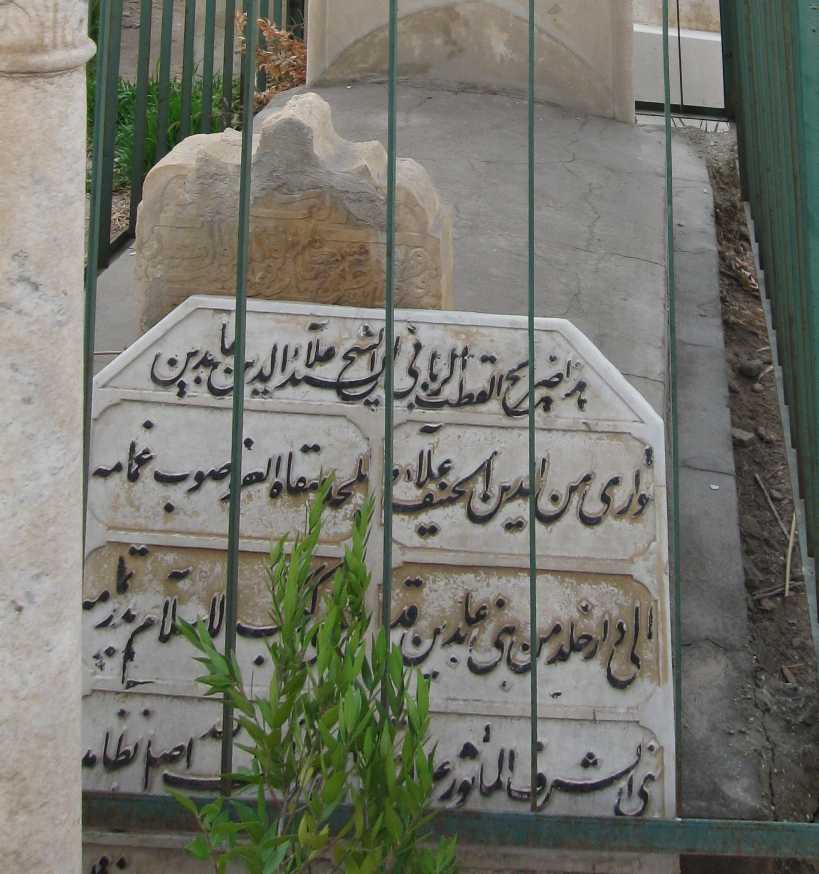 Tomb stone of Sheikh ‘Ala al-Din ‘Abidin (d. 1306 H.) reverse side of the the tombstone of Sheikh Muhammad Amin.
Tomb stone of Sheikh ‘Ala al-Din ‘Abidin (d. 1306 H.) reverse side of the the tombstone of Sheikh Muhammad Amin.(Photo: bmk/ziarat 2009)
Refs
Original site: damas-original.nur.nu
Bio: `Abd Al-Qahir Al-Baghdadi

`Abd Al-Qahir Al-Baghdadi
عبد القاهر البغدادي الشافعي
(d. 429)
radiya Allah anhu
.
English
`Abd al-Qahir ibn Tahir ibn Muhammad, Abu Mansur al-Naysaburi al-Tamimi al-Baghdadi al-Shafi`i al-Ash`ari (d. 429), al-Ustadh, the imam, jurist, scholar of principles and kalam, man of letters, poet, prosodist, grammarian, and mathematician, praised by Shaykh al-Islam Abu `Uthman al-Sabuni as “one of the imams of the principles of the Religion and foremost authorities of Islam by consensus of its most eminent and competent scholars.”
He is al-Bayhaqi’s senior and the exact contemporary of Abu Dharr al-Harawi and Abu Muhammad al-Juwayni among the third-generation Ash`ari imams. He came to Naysabur with his father and spent his entire fortune in support of the scholars of knowledge until he became able to teach in seventeen different disciplines. He was Abu Ishaq al-Isfarayini’s senior student and, together with Abu Sahl al-Su`luki, they staunchly defended the position related from al-Shafi`i that “the Book cannot be abrogated by the Sunna.”1 Abu Mansur succeeded Abu Ishaq al-Isfarayini as headmaster in the mosque of `Aqil, where al-Bayhaqi, Abu al-Qasim al-Qushayri and Nasir al-Marwazi studied under him. He narrated hadith from al-Isma`ili and Abu Ahmad ibn `Adi. Among his works:
- Ahkam al-Wat’ al-Tamm, also known as Iltiqa’ al-Khitanayn, a book on sexual ethics and pertaining laws in Islam, in four volumes.
- Bulugh al-Mada min Usul al-Huda
- Fada’ih al-Karramiyya
- Fada’ih al-Mu`tazila
- al-Fakhir fi al-Awa’il wa al-Awakhir
- al-Farq Bayn al-Firaq, his major heresiological reference-work together with the Milal. In it he states the following positions:
- “It is obligatory to declare as unbeliever someone who says that Allah has limits.” The anthropomorphist creed is that “Allah has limits that He knows of.”
- “Ahl al-Sunna reached consensus that Allah, the Flawless, the Exalted, is not bounded by location.” He then reports the saying of `Ali (r): “Allah created the Throne as an indication of His power, not for taking it as a place for Himself.”
- “Know that Ahl al-Sunna wa al-Jama`a are divided in eight groups of people… the sixth group being the Sufi Ascetics (al-zuhhad al-sufiyya), who have seen things for what they are and therefore have abstained, who have known by experience and therefore have taken heed truly, who have accepted Allah’s allotment and contented themselves with what is within reach.”
- Ibtal al-Qawl bi al-Tawallud
- al-`Imad fi Mawarith al-`Ibad, on inheritance laws.
- al-Iman wa Usuluh
- al-Kalam wa al-Wa`id
- Manaqib al-Imam al-Shafi`i
- Mashariq al-Nur wa Madarik al-Surur fi al-Kalam
- al-Milal wa al-Nihal, a heresiological reference-work.
- Mi`yar al-Nazar
- Nafy Khalq al-Qur’an
- Naqd Abi `Abd Allah al-Jurjani fi Tarjih Madhhab Abi Hanifa in which he states that Imam al-Shafi`i authored a book in refutation of Brahmans in which he adduces the proofs of Prophethood.
- Nasikh al-Qur’an wa Mansukhuh
- al-Qadaya fi al-Dawr wa al-Wasaya
- Sharh Hadith Iftiraq Ummati `ala Ihda wa Sab`in Firqa
- Sharh Miftah Ibn al-Qass on Shafi`i fiqh, in which he states the following positions:
- “The sunna of ablution (wudu’) is to say, upon rinsing one’s hands: Bismillah, wa billah, wa `ala millati Rasulillah — Allah bless and greet him –.”2
- “The sunna of iqama is to dispatch it, but one must not move from his spot while he raises it until he reaches the words qad qamat al-salat.” The Shafi`i position is that one does not move from one’s spot until the end of the iqama once he begins it.3
- “One makes intention for salat al-janaza to accomplish a collective obligation (fard kifaya), as in other obligations.”
- “Some of the Shafi`is forbid the joining of prayer for non-travelers during rain.” The fatwa in the School is the contrary and they consider it permissible even in the absence of rain, when one fears that one will be unable to accomplish prayers in their proper time.
- al-Sifat
- Tafdil al-Faqir al-Sabir `ala al-Ghani al-Shakir
- Tafsir al-Qur’an
- al-Tahsil fi al-Usul
- al-Takmila fi al-Hisab
- Ta’wil Mutashabih al-Akhbar
- Usul al-Din, in which he cites, among those who consider the verse of istiwa’ one of the mutashabihat or Qur’anic ambiguities, Imam Malik ibn Anas, the seven jurists of Madina, and al-Asma`i. In it he states:
- “Allah’s establishment on the Throne is an action He has created named istiwa’ and related to the Throne, just as He has created an action named ityan (coming) related to a certain people; and all this implies neither descent nor movement.”
- “The correct position according to us is the interpretation of the Throne in this verse (20:4) to mean sovereignty (al-mulk), as if He meant that sovereignty has not been established for any but Him. This interpretation is taken from the saying of the Arabs: ‘So-and-so’s throne has toppled’ if he lost his power.” He then cites three examples from Arabic poetry illustrating this. Like Ibn Battal, he attributes the interpretation of istawa as istawla (“He conquered”) chiefly to the Mu`tazila.
- “The book Tarikh al-Sufiyya (History of the Sufis, more commonly known as Tabaqat al-Sufiyya) by Abu `Abd al-Rahman al-Sulami comprises the biographies of nearly a thousand sheikhs of the Sufis, none of whom belonged to heretical sects and all of whom were of the Sunni community, with the exception of only three of them: Abu Hilman of Damascus, who pretended to be of the Sufis but actually believed in incarnationism (hulul); Husayn ibn Mansur al-Hallaj, whose case remains problematic, though Ibn `Ata’ Allah, Ibn Khafif, and Abu al-Qasim al-Nasir Abadi approved of him [as did the Hanbalis Ibn `Aqil, Ibn Qudama, and al-Tufi]; and al-Qannad, whom the Sufis accused of being a Mu`tazili and rejected, for the good does not accept the wicked.”
Toward the end of Abu Mansur al-Baghdadi’s life the Turkmen dissension forced him out of Naysabur to Isfarayin, where he died and was buried next to his teacher Abu Ishaq.
عربي
Refs
Main sources: Ibn `Asakir, Tabyin Kadhib al-Muftari (p. 249-250); al-Dhahabi, Siyar A`lam al-Nubala’ (13:372 #3991); Ibn al-Subki, Tabaqat al-Shafi`iyya al-Kubra (5:136-148 #468).
[1] This position was refuted by Ibn Furak and the majority of Shafi`is, and Ibn al-Subki discussed the dubious authenticity of its attribution to al-Shafi`i in his Sharh al-Minhaj.[2] See al-Shawkani, Nayl al-Awtar, book of Tahara, chapter on the invocations that pertain to ablution (al-tasmiya `ala al-wudu’).
[3] As stated by Ibn al-Subki in al-Tabaqat al-Wusta, cited in his Tabaqat al-Shafi`iyya al-Kubra (5:143 n. 5).
Allah’s Blessings and Peace on the Prophet, his Family, and all his Companions.
© As-Sunna Foundation of America
[permission granted to reproduce with author’s consent.]
© Damas Cultural Society 2007 — Latest update:
Original site: damas-original.nur.nu
Bio: `Abd al-Rahman al-`Ayni

`Abd al-Rahman al-`Ayni
d. 893 in Damascus, Salihiyya
radiya Allah anhu
Buried in MîTûr Jami`al-Jadid in Salihiyyah [Ziarat al-Sham]
Damas Cultural Society © 2007
Bio: `Awf ibn Malik al-Ashja´i

Sayyiduna `Awf ibn Malik al-Ashjari
عوف بن مالك بن أبي عوف الأشجعي
d. 73 H. in Damascus
radiya Allah anhu
ﷺ
He narrated hadith.
English
عربي
عوف بن مالك بن أبي عوف الأشجعي، يكنى أبا عبد الرحمن، ويقال: أبو حماد، وقيل: أبو عمرو.
وأول مشاهده خيبر، وكانت معه راية أشجع يوم الفتح، وسكن الشام. روى عنه من الصحابة: أبو أيوب الأنصاري، وأبو هريرة، والمقدام بن معد يكرب، ومن التابعين: أبو مسلم، وأبو إدريس الخولانيان، وجبير بن نفير، وغيرهم، وقدم مصر.
أنبأنا أبو إسحاق إبراهيم بن محمد وغيره بإسنادهم إلى أبي عيسى محمد بن عيسى: حدثنا هناد، حدثنا عبدة، عن سعيد، عن قتادة، عن أبي المليح، عن عوف بن مالك الأشجعي قال: قال رسول الله صلى الله عليه وسلم: ”أتاني آت من عند ربي فخيرني بين أن يدخل نصف أمتي الجنة، وبين الشفاعة، فاخترت الشفاعة، وهي لمن مات لا يشرك بالله شيئاً”.
وروى كثير بن مرة، عن عوف بن مالك: أنه رأى كعباً يقص في مسجد حمص، فقال: يا ويحه! أما سمع رسول الله صلى الله عليه وسلم يقول: ”لا يقص على الناس إلا أمير، أو مأمور، أو مختال”.
وتوفي بدمشق سنة ثلاث وسبعين، قاله العسكري.
عوف بن مالك بن عبد كلال
عوف بن مالك بن عبد كلال الأعرابي الجشمي، أبو الأحوص. كذا أورده العسكري فيما ذكره ابن أبي علي، عن عم أبيه، عنه.
أخرجه أبو موسى.



